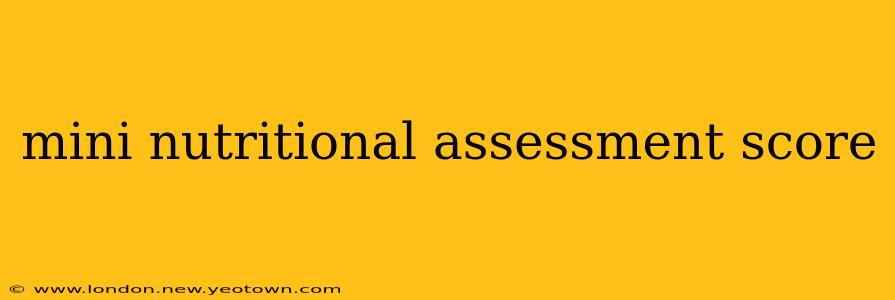The Mini Nutritional Assessment (MNA) isn't just a score; it's a window into your nutritional status, offering valuable insights into your overall health and well-being. This comprehensive guide will unravel the mysteries of the MNA score, helping you understand what it means and how you can use it to improve your health.
Imagine this: You're sitting in your doctor's office, a clipboard rests between you, and your healthcare professional is carefully reviewing your answers to a series of questions. This isn't just a routine checkup; it's a nutritional assessment, and the results are coming in the form of a Mini Nutritional Assessment (MNA) score. Understanding this score is crucial to understanding your nutritional health.
What is the Mini Nutritional Assessment (MNA)?
The MNA is a widely used screening tool designed to identify individuals at risk of malnutrition. It's not a diagnostic test, but rather a quick and easy way to assess your nutritional status. The assessment covers various aspects of your health, including your dietary intake, lifestyle, body weight, and overall health status. The questions are designed to pick up on subtle signs of nutritional deficiency that might otherwise be missed.
How is the MNA Score Calculated?
The MNA is scored using a point system based on your answers to a series of questions. The total score ranges from 0 to 30. A higher score indicates better nutritional health. The scoring system typically divides the assessment into two parts: a short form and a more detailed long form. The short form provides a rapid assessment, while the long form offers a more in-depth evaluation. The precise scoring varies slightly depending on the version of the MNA used.
What Do Different MNA Scores Mean?
The interpretation of MNA scores generally falls into these categories:
-
24 and above: This indicates a good nutritional status. You're likely meeting your nutritional needs and are at a low risk of malnutrition.
-
17-23.5: This is considered at risk of malnutrition. While not currently malnourished, you may be heading towards nutritional deficiencies. It's a critical time to address potential issues and make lifestyle changes.
-
Below 17: This suggests malnutrition. It's vital to seek professional help from a dietitian or doctor to create a personalized plan to address the nutritional deficiencies.
What Factors Influence My MNA Score?
Several factors can impact your MNA score, including:
-
Dietary Habits: Do you consume a balanced diet with sufficient fruits, vegetables, and protein?
-
Medical Conditions: Certain medical conditions can affect nutrient absorption and utilization.
-
Medications: Some medications can interfere with nutrient absorption or increase nutrient requirements.
-
Physical Activity Levels: Regular exercise can positively influence your nutritional status.
-
Body Weight: Significant weight loss or gain can be a red flag.
-
Overall Health Status: Chronic illnesses can affect your ability to consume and absorb nutrients.
How Can I Improve My MNA Score?
If your MNA score is lower than optimal, there are steps you can take to improve it. These may include:
-
Dietary Changes: A registered dietitian can help you create a personalized meal plan to meet your nutritional needs. This might involve focusing on nutrient-dense foods, increasing your intake of fruits and vegetables, or adjusting your protein intake.
-
Lifestyle Modifications: Regular exercise, stress management, and adequate sleep are all important components of overall health and can significantly impact nutritional status.
-
Medical Management: If underlying medical conditions are affecting your nutrition, working closely with your doctor to manage these conditions is crucial.
H2: What are the limitations of the MNA?
The MNA, while useful, has some limitations. It's a screening tool, not a diagnostic test. It doesn't directly measure nutrient levels in the body. Furthermore, cultural and social factors can influence the results, making it vital to consider these factors in interpretation.
H2: How often should I have an MNA?
The frequency of MNA assessments depends on individual risk factors and health status. Individuals at higher risk of malnutrition, such as older adults or those with chronic illnesses, might require more frequent assessments. Your healthcare provider can guide you on appropriate assessment frequency.
H2: Is the MNA suitable for everyone?
While the MNA is widely used, it's primarily designed for older adults (65+). Though it can be adapted for other populations, its interpretation might need adjustments for younger individuals or those with specific health conditions.
Conclusion:
The Mini Nutritional Assessment is a valuable tool for assessing your nutritional health. Understanding your score and addressing any identified risks is crucial for maintaining optimal well-being. Remember to consult with healthcare professionals for personalized advice and support. Taking proactive steps to improve your nutritional status can significantly impact your overall quality of life. A high MNA score isn't just a number; it's a testament to your commitment to a healthy and vibrant life.

